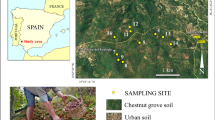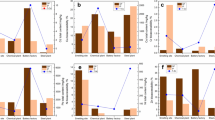Abstract
Bioaccessibility to assess potential risks resulting from exposure to Pb-contaminated soils is commonly estimated using various in vitro methods. However, existing in vitro methods yield different results depending on the composition of the extractant as well as the contaminated soils. For this reason, the relationships between the five commonly used in vitro methods, the Relative Bioavailability Leaching Procedure (RBALP), the unified BioAccessibility Research Group Europe (BARGE) method (UBM), the Solubility Bioaccessibility Research Consortium assay (SBRC), a Physiologically Based Extraction Test (PBET), and the in vitro Digestion Model (RIVM) were quantified statistically using 10 soils from long-term Pb-contaminated mining and smelter sites located in Western Australia and South Australia. For all 10 soils, the measured Pb bioaccessibility regarding all in vitro methods varied from 1.9 to 106 % for gastric phase, which is higher than that for intestinal phase: 0.2 ∼ 78.6 %. The variations in Pb bioaccessibility depend on the in vitro models being used, suggesting that the method chosen for bioaccessibility assessment must be validated against in vivo studies prior to use for predicting risk. Regression studies between RBALP and SRBC, RBALP and RIVM (0.06) (0.06 g of soil in each tube, S:L ratios for gastric phase and intestinal phase are 1:375 and 1:958, respectively) showed that Pb bioaccessibility based on the three methods were comparable. Meanwhile, the slopes between RBALP and UBM, RBALP and RIVM (0.6) (0.6 g soil in each tube, S:L ratios for gastric phase and intestinal phase are 1:37.5 and 1:96, respectively) were 1.21 and 1.02, respectively. The findings presented in this study could help standardize in vitro bioaccessibility measurements and provide a scientific basis for further relating Pb bioavailability and soil properties.


Similar content being viewed by others
References
Bruce S, Noller B, Matanitobua V, Ng J (2007) In vitro physiologically based extraction test (PBET) and bioaccessibility of arsenic and lead from various mine waste materials. J Toxicol Environ Health Part A 70:1700–1711
Casteel SW, Cowart RP, Weis CP, Henningsen GM, Hoffman E, Brattin WJ, Guzman RE, Starost MF, Payne JT, Stockham SL, Becker SV, Drexler JW, Turk JR (1997) Bioavailability of lead to juvenile swine dosed with soil from the Smuggler Mountain NPL site of Aspen, Colorado. Fundam Appl Toxicol 36:177–187
Casteel SW, Weis CP, Henningsen GM, Brattin WJ (2006) Estimation of relative bioavailability of lead in soil and soil-like materials using young swine. Environ Health Persp 114:1162–1171
Chiodo LM, Jacobson SW, Jacobson JL (2004) Neurodevelopmental effects of postnatal lead exposure at very low levels. Neurotoxicol Teratol 26:359–371
Denys S, Caboche J, Tack K, Rychen G, Wragg J, Cave M, Jondreville C, Feidt C (2012) In vivo validation of the unified BARGE method to assess the bioaccessibility of arsenic, antimony, cadmium, and lead in soils. Environ Sci Technol 46:6252–6260
Deshommes E, Tardif R, Edwards M, Sauve S, Prevost M (2012) Experimental determination of the oral bioavailability and bioaccessibility of lead particles. Chem Cent J 6
Drexler JW, Brattin WJ (2007) An in vitro procedure for estimation of lead relative bioavailability: With validation. Hum Ecol Risk Assess 13:383–401
Gillman G, Sumpter E (1986) Modification to the compulsive exchange method for measuring exchange characteristics of soils. Soil Res 24:61–66
Hamel SC, Buckley B, Lioy PJ (1998) Bioaccessibility of metals in soils for different liquid to solid ratios in synthetic gastric fluid. Environ Sci Technol 32:358–362
Hettiarachchi GM, Pierzynski GM, Oehme FW, Sonmez O, Ryan JA (2003) Treatment of contaminated soil with phosphorus and manganese oxide reduces lead absorption by Sprague–Dawley rats. J Environ Qual 32:1335–1345
Juhasz AL, Weber J, Smith E, Naidu R, Marschner B, Rees M, Rofe A, Kuchel T, Sansom L (2009) Evaluation of SBRC-gastric and SBRC-intestinal methods for the prediction of in vivo relative lead bioavailability in contaminated soils. Environ Sci Technol 43:4503–4509
Juhasz AL, Smith E, Weber J, Rees M, Kuchel T, Rofe A, Sansom L, Naidu R (2013) Predicting lead relative bioavailability in peri-urban contaminated soils using in vitro bioaccessibility assays. J Environ Sci Health A 48:604–611
Lanphear BP, Hornung R, Ho M, Howard CR, Eberly S, Knauf K (2002) Environmental lead exposure during early childhood. J Pediatr 140:40–47
Li H-B, Cui X-Y, Li K, Li J, Juhasz AL, Ma LQ (2014) Assessment of in vitro lead bioaccessibility in house dust and its relationship to in vivo lead relative bioavailability. Environ Sci Technol 48:8548–8555
Li J, Li K, Cave M, Li H-B, Ma LQ (2015) Lead bioaccessibility in 12 contaminated soils from China: correlation to lead relative bioavailability and lead in different fractions. J Hazard Mater 295:55–62
Lidsky TI, Schneider JS (2003) Lead neurotoxicity in children: basic mechanisms and clinical correlates. Brain 126:5–19
Naidu R, Channey R, McConnell S, Johnston N, Semple KT, McGrath S, Dries V, Nathanail P, Harmsen J, Pruszinski A (2013) Towards bioavailability-based soil criteria: past, present and future perspectives. Environ Sci Pollut Res, 1–7
National Environment Protection Council A (1999) National environment protection (assessment of site contamination) measure. In: Council NEP (Hrsg.). National Environment Protection Council, Adelaide
Needleman HL, Gatsonis CA (1990) Low-level lead exposure and the IQ of children: a meta-analysis of modern studies. Jama 263:673–678
Oomen AG, Hack A, Minekus M, Zeijdner E, Cornelis C, Schoeters G, Verstraete W, Van de Wiele T, Wragg J, Rompelberg CJ (2002) Comparison of five in vitro digestion models to study the bioaccessibility of soil contaminants. Environ Sci Technol 36:3326–3334
Oomen AG, Tolls J, Sips A, Van den Hoop MA (2003) Lead speciation in artificial human digestive fluid. Arch Environ Contam Toxicol 44:0107–0115
Oomen AG, Brandon EFA, Swartjes FA, Sips A 2006: How can information on oral bioavailability improve human health risk assessment for lead-contaminated soils? Implementation and scientific basis, Rijksinstituut voor Volksgezondheid en Milieu RIVM, Bilthoven
Rieuwerts J, Thornton I, Farago M, Ashmore M (1998) Factors influencing metal bioavailability in soils: preliminary investigations for the development of a critical loads approach for metals. Chem Spec Bioavailab 10:61–75
Ruby MV, Davis A, Schoof R, Eberle S, Sellstone CM (1996) Estimation of lead and arsenic bioavailability using a physiologically based extraction test. Environ Sci Technol 30:422–430
Ruby M, Schoof R, Brattin W, Goldade M, Post G, Harnois M, Mosby D, Casteel S, Berti W, Carpenter M (1999) Advances in evaluating the oral bioavailability of inorganics in soil for use in human health risk assessment. Environ Sci Technol 33:3697–3705
Schumacher BA (2002) Methods for the determination of total organic carbon (TOC) in soils and sediments. Ecol Risk Assess Support Cent 2002:1–23
Shannon M (1998) Lead poisoning from an unexpected source in a 4-month-old infant. Environ Health Persp 106:313
Smith E, Kempson IM, Juhasz AL, Weber J, Rofe A, Gancarz D, Naidu R, McLaren RG, Gräfe M (2011) In vivo–in vitro and XANES spectroscopy assessments of lead bioavailability in contaminated periurban soils. Environ Sci Technol 45:6145–6152
Sorenson B, Oelsligle D, Knodsen D (1971) Extraction of zinc, iron, and manganese from soils with 0.1 N hydrochloric acid as affected by soil properties solution: Soil ratio, and length of extraction period. Soil Sci, 352–359
U.S. Environmental Protection Agency (2007a) Guidance for evaluating the oral bioavailability of metals in soils for use in human health risk assessment. In: Agency USEP (Hrsg.). U.S. Environmental Protection Agency, Washington
U.S. Environmental Protection Agency (2007b) Estimation of relative bioavailability of lead in soil and soil-like materials using in vivo and in vitro methods. In: Office of Solid Waste and Emergency Response USEPA (Hrsg.). U.S. Environmental Protection Agency, Washington
U.S. Environmental Protection Agency (2008) Final national ambient air quality standards for lead. In: Office of Air Quality Planning and Standards USEPA (Hrsg.). U.S. Environmental Protection Agency, washington
U.S. Environmental Protection Agency (2014) Human health risk assessment research. In: U.S. Environmental Protection Agency (Hrsg.). U.S. Environmental Protection Agency, Washington
Van de Wiele TR, Oomen AG, Wragg J, Cave M, Minekus M, Hack A, Cornelis C, Rompelberg CJM, De Zwart LL, Klinck B, Van Wijnen J, Verstraete W, Sips AJAM (2007) Comparison of five in vitro digestion models to in vivo experimental results: lead bioaccessibility in the human gastrointestinal tract. J Environ Sci Heal A 42:1203–1211
Ziegler EE, Edwards BB, Jensen RL, Mahaffey KR, Fomon SJ (1978) Absorption and retention of lead by infants. Pediatr Res 12:29–34
Acknowledgments
We would like to thank the Cooperative Research Centre for Contamination Assessment and Remediation of the Environment (CRC CARE) for funding support, and the Centre for Environmental Risk Assessment and Remediation (CERAR), University of South Australia for the use of their facilities.
Author information
Authors and Affiliations
Corresponding author
Additional information
Responsible editor: Marcus Schulz
Rights and permissions
About this article
Cite this article
Yan, K., Dong, Z., Liu, Y. et al. Quantifying statistical relationships between commonly used in vitro models for estimating lead bioaccessibility. Environ Sci Pollut Res 23, 6873–6882 (2016). https://doi.org/10.1007/s11356-015-5947-8
Received:
Accepted:
Published:
Issue Date:
DOI: https://doi.org/10.1007/s11356-015-5947-8




